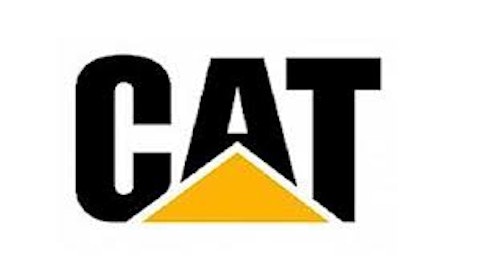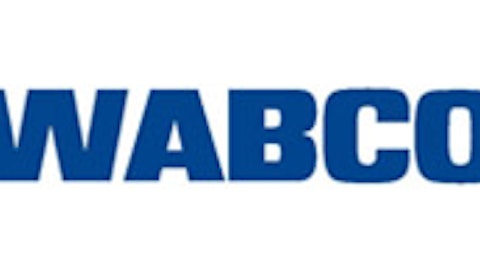
Will revenues start to pick up?
Caterpillar Inc. (NYSE:CAT) has recently revised its 2013 outlook. The company projects its revenue will range between $56 billion and $57 billion in 2013, which represents a drop in sales of 12% to 15% (year-over-year). The company’s average revenue estimate is nearly 3.4% below its previous estimate. Considering the company’s net sales in the first half of 2013 are roughly 16.6% below last year’s net sales, this means the company’s revenue will have to start to pick up in order to reach its current lower bound of its net revenue projection. Based on the recent developments in China and the U.S (I will elaborate further on these regions below) the company might not meet its current projections, which could further pull back its stock price.
Some heavy machinery companies haven’t done much better. Net revenue at Cummins Inc. (NYSE:CMI) fell by 12% in the first quarter (year-over-year). But this wasn’t the case for Deere & Company (NYSE:DE), as its revenue grew by 9% in the recent quarter (ended April 30).
In the mean time, Caterpillar Inc. (NYSE:CAT) is giving back some of its funds to its stockholders not only via dividend payment, which currently stands on an annual yield of 2.9%, but also via its stock repurchase program.
If we look at the main regions Caterpillar Inc. (NYSE:CAT) operates in, based on dealers’ statistics the sharpest fall is in the Asia/Pacific followed by North America. The only region that seems to keep growing in sales is Latin America. Let’s take a closer look at these three regions.
Asia/Pacific
Caterpillar Inc. (NYSE:CAT)’s main countries in this region include China. Regarding China, the country’s economic slowdown may keep adversely affecting the growth in revenues of the company. Moreover, the company’s bad experiences in this country from the acquisition of Siwei might pull back Caterpillar’s growth in China, as this experience will make the management reconsider purchasing additional companies in China anytime soon.
Deere & Company (NYSE:DE) also expects its revenues won’t grow in its agriculture and turf segment during the year, which could curb down its growth in total net sales.
North America
The ongoing recovery of the U.S housing market is likely to keep pulling up the demand for Caterpillar’s products in the near future. On the other hand, the U.S government continues to cut down its investment in infrastructure projects, which could hurt Caterpillar’s revenue in those segments. If the U.S government will keep cutting down the federal budget in the coming years, this is likely to adversely affect the budget allocated towards public housing and infrastructure projects. Therefore, Caterpillar’s growth in revenue in the U.S could slow down in the coming years, even if the housing market will keep growing.
These potential developments could also adversely affect other companies. Cummins had a 15% drop in revenue in North America in its engine, components and distribution segments. Deere also expects its net revenues in its prime business segment – agriculture and turf equipment – won’t rise in 2013.
Latin America
This region accounted for only 14% of Caterpillar’s revenue in 2012. So why is this region important? In 2012 the three regions with the highest growth rates in net sales were Asia/Pacific, Latin America and North America (in that order). The economic slowdown in China and the potential decline in revenue in the U.S. suggest Latin America might lead the way in growth in sales.
This region is likely to be the driving force for companies such as Deere. The company projects net revenue in its agriculture and turf, a business segment that accounts for more than 80% of Deere total revenues, will increase by 15%-20% in 2013 mainly due to growth in Brazil’s economy. Therefore, this region’s economic direction will determine the growth (or lack of it) of these heavy machinery manufacturers.
Profitability also falls
Caterpillar’s drop in revenue isn’t the only decline the company experienced; its profit margins also dwindled in recent quarters. In the second quarter, the company’s profitability reached 10.65% compared to 15.06% in the same quarter in 2012.
In comparison, in the recent quarter, Deere’s profit margin reached 16%, which was close to its profitability last year. Cummins Inc. (NYSE:CMI), much like Caterpillar, experienced a drop in profitability; in the first quarter, profit margin slid to 10.6%. If Caterpillar’s profit margin will further dwindle, not only could it adversely affect its stock price, but also its dividend payment.
Valuation
Despite the drop in the share price of Caterpillar, its current enterprise-value-to-EBIT ratio remains the highest of the three companies listed above. I have used this ratio because it takes into account the financial structure of the company including its cash and debt.
Deere’s ratio is close to the machinery market average, and Cummins Inc. (NYSE:CMI)’s ratio is slightly lower than the market average. This means, at face value, that all three companies are roughly priced at the same ballpark and next to the market average.
The table below summarizes the valuation of all three companies based on enterprise-value-to-EBIT ratio.

The Foolish bottom line
Don’t get me wrong, I think Caterpillar is still a great company with solid foundations that could make great strides over time. But the future economic developments in China and the U.S may further pull down its revenues and profit margins. The company’s current valuation is still slightly higher than other leading heavy machinery companies (but not by much), which makes its current valuation less appealing. But if the company’s stock price will continue to fall, it will eventually lead to an opportunity worth considering — an opportunity that will make this company’s stock worth adding to your portfolio.
The article Is This Cat About to Pounce Back? originally appeared on Fool.com and is written by Lior Cohen.
Lior Cohen has no position in any stocks mentioned. The Motley Fool recommends Cummins. The Motley Fool owns shares of Cummins. Lior is a member of The Motley Fool Blog Network — entries represent the personal opinion of the blogger and are not formally edited.
Copyright © 1995 – 2013 The Motley Fool, LLC. All rights reserved. The Motley Fool has a disclosure policy.




